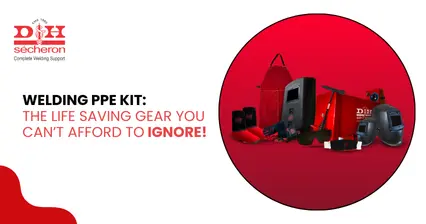Ways to Prevent Weld Defects When Working with Different Materials – A Comprehensive Guide
When it comes to welding, producing strong and flawless welds is the ultimate goal. At D&H Sécheron, we understand the importance of weld quality and the challenges that arise when working with different materials. In this informative blog, we'll explore effective ways to prevent welding defects and ensure optimal weld strength.
Understanding Welding Defects:
Welding defects can arise from various factors, including improper technique, inadequate preparation, and the unique properties of the materials being joined. These defects not only compromise the structural integrity of the weld but also affect its overall performance and longevity. To achieve impeccable welds, it's crucial to address potential defects before they manifest.
1. Thorough Material Analysis and Selection
Different materials have distinct characteristics, including thermal conductivity, melting points, and expansion rates. Before initiating any welding project, it's essential to conduct a comprehensive analysis of the materials being joined. This analysis allows you to determine the optimal welding process, filler materials, and welding parameters to ensure a harmonious fusion of metals.
2. Proper Welding Technique and Parameters
Selecting the appropriate welding technique and parameters is vital when working with diverse materials. Adjusting the heat input, travel speed, and electrode size based on the material's properties helps prevent overheating, distortion, and inadequate fusion. D&H Sécheron, as one of the leading welding companies in India, offers expert guidance to help you fine-tune your welding techniques for superior results.
3. Pristine Material Preparation
Effective welding begins with proper material preparation. Thoroughly cleaning and degreasing the base metals remove contaminants that can contribute to defects. Additionally, precise bevelling and alignment of joint edges ensure optimal penetration and fusion during the welding process, enhancing the weld's strength and integrity.
4. Metallurgical Compatibility
Welding materials with varying metallurgical compositions can pose challenges. It's essential to understand the potential reactions between different materials to prevent defects such as cracking, porosity, and brittle welds. Employing compatible filler materials and adopting appropriate preheating techniques can mitigate these challenges and enhance weld quality.
5. Shielding Gas and Flux Selection
The choice of shielding gas or flux plays a critical role in preventing defects, especially in processes like MIG and TIG welding. Proper selection of these elements creates a protective atmosphere that shields the weld pool from atmospheric contamination, reducing the risk of defects such as porosity and oxidation.
Conclusion:
Understanding the unique challenges associated with different materials and implementing effective preventive measures helps to ensure seamless welds with exceptional strength and durability. D&H Sécheron is here to guide you every step of the way, offering top-notch welding advice, high-quality materials, and unparalleled support to elevate your welding projects to new heights.
At D&H Sécheron, we take pride in being a reliable partner in your welding endeavors. Our commitment to quality, expertise, and innovation makes us stand out among welding companies in India. We provide a comprehensive range of welding materials, including filler rods, electrodes, and fluxes, all designed to enhance your welding experience and help you achieve impeccable welds.
11 May 2025 | Welding
An In-Depth Exploration of Low-Alloy Steel: Your Comprehensive Guide
11 May 2025 | Welding
Nagpur - Bori - Tuljapur Road MSH-3 in Yavatmal District (Maharashtra)
11 May 2025 | Welding
Guidelines to Understand Gas Welding: Applications, Advantages & Disadvantages
11 May 2025 | Welding
3 Tips for Finding the Best Mild Steel Electrode for Your Application
11 May 2025 | Welding
How to Select the Right Welding Filler Wires for Stainless Steel Welding?
11 May 2025 | Welding
Building the Narendra Modi Stadium with Norma V and Autotherme-1 Electrodes
11 May 2025 | Welding
Low Alloy Steel Welding in a (PEB) Pre Engineered Building Structure
11 May 2025 | Welding
Welding Rods: Different Types and Tips for Properly Storing and Handling
11 May 2025 | Welding
Tips for Flawless Welds with Stainless Steel Electrodes: Pros and Cons
11 May 2025 | Welding
Exploring Applications and Benefits of Stainless Steel Welding Electrodes
11 May 2025 | Welding
Welding Basics: Joining Metals with Heat and Pressure - A Beginners Guide
11 May 2025 | Welding
Distinguishing Low-Alloy Steel from High-Alloy Steel: Understanding the Variations
11 May 2025 | Welding
Hard Facing Wire - Understanding the Process and Achieving Optimal Result
11 May 2025 | Welding
Exploring the Advantages of Stainless Steel Electrodes in Welding Applications
11 May 2025 | Welding
Weathering Steel vs. Traditional Steel: A Comparative Analysis of Performance
11 May 2025 | Welding
Choosing the Right Welding Rod: Why 6013 Electrodes Might Be Your Ideal Option
11 May 2025 | Welding
Why 7018 Electrodes Are Preferred for High-Strength Welds in Pipeline Construction
11 May 2025 | Welding
Filler Wire vs. Stainless Steel Filler Wire: Understanding the Key Differences
11 May 2025 | Welding
Exploring the Impact of Filler Material on Welding Quality and Durability
11 May 2025 | Welding
Choosing the Right Cast Iron Electrode for Different Welding Projects
11 May 2025 | Welding
Top Advantages of Cast Iron Electrodes for Industrial Welding Applications
11 May 2025 | Welding
Key Benefits and Challenges of Using TIG Welding in Industrial Projects
11 May 2025 | Welding
5 Reasons Why 7018 Electrode is the Gold Standard for Welding Professionals
11 May 2025 | Welding
Top 5 Advantages of Flux Cored Arc Welding for Heavy-Duty Applications.png)
11 May 2025 | Welding
Lotherme-601: A Game-Changer for Restoring Shoulder Pins in Heavy Machinery
11 May 2025 | Welding
How D&H Sécheron Helped Repair a Rotary Kiln’s Cooler Section with LoTherme 352
11 May 2025 | Welding
Piston Repair for Mining Industry: Cost-Effective Solutions with LoTherme 468.webp)






.jpg)







































.jpg)
.jpg)

.jpg)

.jpg)





.jpg)
.jpg)
.jpg)



.webp)
.jpg)
.jpg)
.webp)
.jpg)






















.png)



.webp)

.webp)
.webp)



